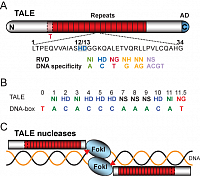Jens Boch
Dr. Jens Boch

Institute of Biology/General Genetics
Weinbergweg 10
06120 Halle (Saale)
phone: +49 (0) 345-55 26298
jens.boch@genetik.uni-halle.de
Maik Reschke

PhD student
Generation of resistant rice by targeted genome engineering using TALENs
Rice is one of the most important food crops worldwide providing the primary source of calories for half of the world population. Plant-pathogenic Xanthomonas oryzae pv. oryzae (Xoo) and Xanthomonas oryzae pv. oryzicola (Xoc) bacteria cause severe diseases of rice with up to 50% harvest losses. TAL effectors (TALEs) are potent virulence factors of Xoo and Xoc that function as specific transcription factors inside the plant nucleus.
The DNA-binding specificity of TALEs is encoded by tandem 34-amino acid repeats in the protein. Each repeat directs binding to one DNA base pair (bp), and a repeat-variable diresidue (RVD) per repeat determines the bp specificity (Fig. 1). Artificial TALEs with designer DNA-binding specificity can be constructed by pre-arranging the repeats. This feature makes TALEs a unique tool for biotechnology.
Highly site-specific TALE nucleases (TALENs) can introduce single cuts in complex genomes. These cuts are typically repaired by the cell, which leads to short indel mutations or insertion of template DNA. Hence, TALENs are suitable for targeted genome engineering in the absence of efficient homologous recombination.
In this project we plan to establish and further develop the TALEN technology. We will apply TALENs for the generation of novel rice resistances functional against Xoo and Xoc. To achieve this, we will bioinformatically predict and experimentally validate virulence targets of natural TALEs from Xoo and Xoc. Chirurgic mutations will then be introduced into target rice genes to prevent the function of natural TALEs and immunize the plants against one of Xanthomonas' most potent weapons.

TALEs and TALENs have a modular and programmable DNA-binding domain. A, Central 34-amino acid repeats each bind one DNA base. A repeat-variable diresidue (RVD) determines the specificity. B, RVDs and target sequence of a TALE. C, TALE nuclease (TALEN) pair. Dimerisation of FokI domains from neighboring TALENs triggers DNA cleavage (red triangles).
